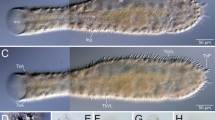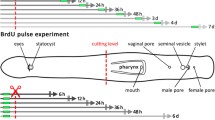Abstract
The original description of the nemertodermatid flatworm,Meara stichopi, reported the occurrence of distinct “restitution cells” in the epidermis. An ultrastructural investigation of these objects was undertaken. We found cell bodies with an ultrastructure similar to “pulsatile bodies” reported from Acoela. The cells are clearly the result of a degeneration process, not of regeneration. They are old epidermal cells which are with-drawn from the epidermis to the digestive tissue, evidently for resorption. A peculiarity of the degenerating epidermal cells ofM. stichopi is that the cilia are most often detached before the cell is withdrawn from the epidermal surface, resulting in an inability to pulsate. Thus, we suggest that the term “pulsatile body” is replaced by the more inclusive and informative term “degenerating epidermal body”. The results support the hypothesis put forward by Ehlers that these bodies represent a synapomorphic character state for the Nemertodermatida and the Acoela.
Similar content being viewed by others
References
Beklemischev WN (1915) Sur les turbellariés parasites de la côte Mourmanne. I. Acoela. Trav Soc Nat Pétrograd 43:103–172
Delage Y (1886) Etudes histologiques sur les planaries rhabdocoeles acoeles (Convoluta schultzii O. Sch.). Arch. Zool Exp Gén 4:109–144
Dorey AE (1965) The organization and replacement of the epidermis in acoelous turbellarians. Q J Microsc Sci 106:147–172
Ehlers U (1985) Das phylogenetische System der Plathelminthes. Gustav Fisher, Stuttgart
Ehlers U (1992a) On the fine structure ofParatomella rubra Rieger & Ott (Acoela) and the position of the taxonParatomella Dörjes in a phylogenetic system of the Acoelomorpha (Plathelminthes). Microfauna Mar 7:265–293
Ehlers U (1992b) “Pulsatile bodies” inAnaperus tvaerminnensis (Luther, 1912) (Acoela, Plathelminthes) are degenerating epidermal cells. Microfauna Mar 7:295–310
Franzén Å, Afzélius BA (1987) The ciliated epidermis ofXenoturbella bocki (Platyhelminthes, Xenoturbellida) with some phylogenetic considerations. Zool Scr 16:9–17
Geddes P (1879) Observations on the physiology and histology ofConvoluta schultzii. Proc R Soc London 28:449–457
Lundin K, Hendelberg, J (1995) Ultrastructure of the epidermis ofMeara stichopi (Platyhelminthes, Nemertodermatida) and associated extraepidermal bacteria. Hydrobiologia 305:161–165
Mamkaev YuV (1965) Etude morphologique d'Actinoposthia beklemischevi n.sp. (Turbellaria, Acoela). Cah Biol Mar 6:23–50
Rieger RM, Tyler S, Smith JPS, Rieger GE (1991) Platyhelminthes: Turbellaria. In: Harrison FW (ed) Microscopic anatomy of invertebrates 3:7–140. Wiley-Liss, New York
Rohde K, Watson N, Cannon LRG (1988) Ultrastructure of epidermal cilia ofPseudactinoposthia sp. (Platyhelminthes, Acoela); implications for the phylogenetic status of the Xenoturbellida and Acoelomorpha. J Submicrosc Cytol Pathol 20:759–767
Smith III JPS, Tyler S (1985) The acoel tubellarians: kingpins of metazoan evolution or a specialized offshoot? In: Conway Morris C, George JD, Gibson R, Platt HM (eds) The origins and relationships of lower invertebrates. Oxford University Press, Oxford, pp 123–142
Smith III JPS, Tyler S, Rieger RM (1986) Is the Turbellaria polyphylectic? Hydrobiologia 132:13–21
Tyler S (1984) Turbellarian platyhelminths. In: Bereiter-Hahn J, Matoltsy AG, Richards KS (eds) Biology of the integument, vol 1. Invertebrates. Springer, Berlin, pp 112–131
Tyler S, Rieger RM (1977) Ultrastructural evidence for the systematic position of the Nemertodermatida (Turbellaria). Acta Zool Fenn 154:193–207
Tyler S, Grimm JK, Smith III JPS (1989) Dynamics of epidermal wound repair in acoel turbellarians—the role of pulsatile bodies. Am Zool 29:115A
Westblad E (1940) Studien über skandinavische Turbellaria Acoela. I. Ark Zool 32A, 20:1–28
Westblad E (1949) OnMeara stichopi (Bock) Westblad, a new representative of Turbellaria Archoophora. Ark Zool 1 (5):43–57
Author information
Authors and Affiliations
Rights and permissions
About this article
Cite this article
Lundin, K., Hendelberg, J. Degenerating epidermal bodies (“pulsatile bodies”) inMeara stichopi (Plathelminthes, Nemertodermatida). Zoomorphology 116, 1–5 (1996). https://doi.org/10.1007/BF02526924
Accepted:
Issue Date:
DOI: https://doi.org/10.1007/BF02526924




